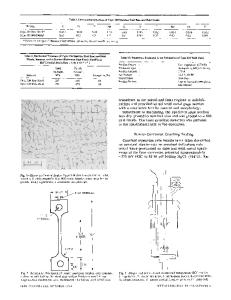The Effect of Multiple Shot Peening on the Corrosion Behavior of Duplex Stainless Steel
- PDF / 1,767,204 Bytes
- 8 Pages / 593.972 x 792 pts Page_size
- 69 Downloads / 264 Views
JMEPEG (2018) 27:1396–1403 https://doi.org/10.1007/s11665-018-3204-2
The Effect of Multiple Shot Peening on the Corrosion Behavior of Duplex Stainless Steel Qiang Feng, Jia She, Xueyan Wu, Chengxi Wang, and Chuanhai Jiang (Submitted November 26, 2015; in revised form December 29, 2017; published online February 1, 2018) Various types of shot peening treatments were applied to duplex stainless steel. The effects of shot peening intensity and working procedures on the microstructure were investigated. The domain size and microstrain evolution in the surface layer were characterized utilizing the Rietveld method. As the shot peening intensity increased, the surface roughness increased in the surface layer; however, it decreased after multiple (dual and triple) shot peening. The mole fraction of strain-induced martensite as a function of the intensity of shot peening was evaluated by XRD measurements. Both potentiodynamic polarization curves and salt spray tests of shot-peened samples in NaCl solution were investigated. The results indicate that traditional shot peening has negative effects on corrosion resistance with increasing shot peening intensity; however, the corrosion rate can be reduced by means of multiple shot peening. Keywords
duplex stainless steel, shot peening, corrosion resistance, Rietveld method
1. Introduction Duplex stainless steel (DSS) consists of approximately equal amounts of austenite and ferrite and often combines the excellent performance of austenitic and ferritic steel. DSS S32205 has a volume fraction of each phase that is no less than 30%, which gives rise to salutary mechanical performance and corrosion resistance. Even so, the low stiffness and low wear resistance of this steel result in poor tribological performance (Ref 1-5). It is worth improving the stiffness and wear resistance of DSS without the loss of corrosion resistance, which could significantly extend its applications. Shot peening (SP) is an effective surface treatment that can introduce beneficial deformation and compressive residual stress microstructures to metal parts for industrial applications, which results in improvements to their fatigue life, stress corrosion resistance, etc. As far as the strengthening mechanism is concerned, it is well known that it involves stress reinforcement and microstructural reinforcement. The enhancement produced by SP mainly depends on the SP method and intensity. To date, various effects of SP on stainless steel, such as induced microstructure, martensitic transformation and residual stress, have been reported (Ref 5-7). However, the investigation of multiple SP process parameters related to DSSinduced deformation of the surface layer and the connection with corrosion performance is less studied even though Qiang Feng, College of Physics and Engineering, Chengdu Normal University, No.99, Haike Road, Easten Section, Wenjiang District, Chengdu, Sichuan 611130, PR China; Jia She, College of Materials Science and Engineering, Chongqing University, Chongqing 400044, PR China; and Xueyan Wu,
Data Loading...











